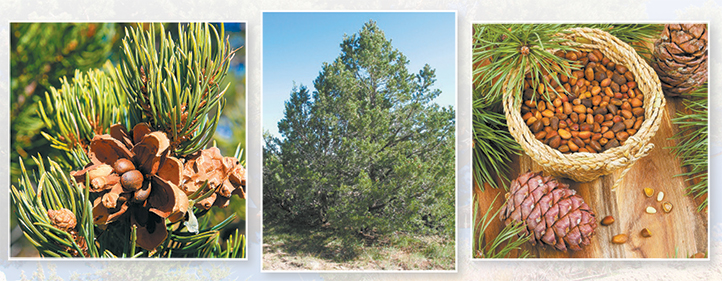
Single-Needle Pinyou
The pinyou/juniper woodlands are found throughout much of the state of Nevada. Earlier I wrote of Juniperus osteosperma the Utah Juniper. This plant and single needle pinyou (Pinus monophylla makep most of the pinyou/juniper woodlands in Nevada and thus are of interest to all who are interested in Nevada’s rangelands. So what is single-needle pinyon? The single-needle pinyon is an aromatic pine tree with short, stiff needles and gnarled branches that grow mostly in coarse rocky soils. Normal height for this tree is about 15 feet, but the tree can grow as high as 50 feet under ideal conditions. These woodlands cover more that 55.6 million acres in the western Unites States. They along with the Utah Juniper and few other tree species comprise one of Nevada’s most extensive vegetation types covering some 14,178 square miles or approximately thirteen percent of Nevada’s land area. As one travels around the state they appear as tree covered hill slopes on distant mountain ranges. There is some evidence that the woodlands have increased over time but how much and how long the stands will last is up for debate.
Single-needle pinyon generally dominates the woodland in the upper and intermediate elevation bands. Nevada designated the single-needle pinyon as the official state tree in 1953. (Nevada adopted a second state tree in 1987; bristlecone pine). Variations in elevation create an ecotone between the Juniper and Pinyon species, where they can commonly overlap at around an elevation of 5,000 feet. They are sometimes scorned by real foresters as they refer to them as part of the pygmy forest.
Single-needle pinyon pines have a very slow growth pattern and can take almost a century to reach 12 meters in height. This woodland habitat is not highly adapted to fire. Fuel loads are often not sufficient enough to maintain a devastating fire, although many understory plants are particularly vulnerable to wildfires. Prescribed fire has been applied to pinyon woodlands in order to manage the land, clear the landscape for new recruitment, or for grazing. Many acres of these trees have been cut over for the making of charcoal to smelt ore during early mining. Ranchers have used the wood to warm themselves and provide fence posts to aid in the management of their livestock. Several decades ago some acreage of the woodland were chained. Large chains were drawn behind large caterpillar tractors to topple and cut down the trees to “release” the understory plants for livestock and wildlife use. This practice was stopped after many of the preservationist groups complained.
The stands vary from essentially closed stand with little understory species especially forage plants to open stands with a variety of understory species many of which are useful for livestock use. However, as vegetation progresses from an open sagebrush community with scattered trees to dense woodland, herbaceous plants and shrubs decrease and are thus unavailable as forage for livestock. Bleached skeletons of sagebrush remain as the only evidence of the former shrub- and grass-dominated community. Scattered remnant clumps of bunch grasses hang on at the peripheries of the tree crowns, where the proper balance of shade, sun, and competition with tree roots for water allows them to persist in this harsh environment.
The seeds of the pinyon pine, known as “pine nuts” or “piñóns”, are an important food for American Indians living in the mountains of Nevada. Many pines produce edible seeds, but in North America only pinyon produces seeds large enough to be a major source of food. The pinyon has likely been a source of food since the arrival of homo sapiens in the Great Basin. Archaeological evidence indicates that the range of the pinyon pine expanded northward after the Ice Age, reaching its northernmost (and present) limit in southern Idaho about 4000 BC. Early Native Americans undoubtedly collected the edible seeds, but, at least in some areas, evidence of large quantities of pinyon nut harvesting does not appear until about 600 AD. Increased use of pinyon nuts was possibly related to a population increase of humans and a decline in the number of game animals, thereby forcing Great Basin inhabitants to seek additional sources of food.
The suitability of pinyon seeds as a staple food is reduced because of the unreliability of the harvest. Abundant crops of cones and seeds occur only every two to seven years, averaging a good crop every four years. Years of high production of seed tend to be the same over wide areas of the pinyon range. The pinyon jay (Gymnorhinus cyanocephalus) takes its name from the tree, and pinyon nuts form an important part of its diet. It is very important for regeneration of pinyon woods, as it stores large numbers of the seeds in the ground for later use, and excess seeds not used are in an ideal position to grow into new trees.
By Paul T. Tueller, Ph.D., CRMC
